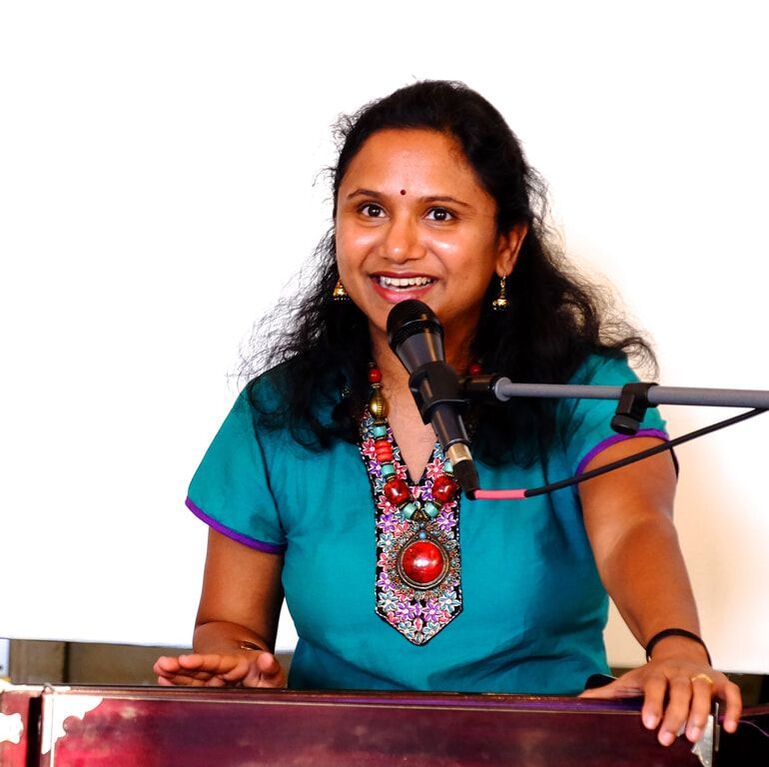Program
| In Preparation of Shiva Ratri | Kamini Natarajan |
|
Kamini Natarajan, vocals and harmonium Saheb Singh, Tabla Shivali Chandrashekar, additional vocals |
|
| Om Namah Shivaya | Kamini Natarajan |
|
Kamini Natarajan, vocals and harmonium Saheb Singh, Tabla Shivali Chandrashekar, additional vocals |
|
I have appreciated the opportunity to become more familiar with Hinduism and the older Vedic tradition that preceded it. Hinduism itself is not monolithic, but as diverse as the pantheon of gods revered and the tradition depending on a particular philosophical school and perspective or regional cultural customs that have developed over the centuries. A common perception of Hinduism is that it is a polytheistic religion. At the core of most Hindu belief systems, however, is an underlying Monotheism revolving around the one God Brahma, a representation of ultimate reality.
The vast pantheon of Gods, while worshiped and revered individually, are reflections of the multifaceted nature of Brahma, which is to say the multifaceted nature of reality itself, and each is an opportunity to focus on, and celebrate, one aspect of the world we live in. Unlike the Middle Eastern monotheistic religions like Christianity and Islam that focus on the dualism between good and evil forces, the gods of Hinduism are all respected as inevitable parts of the world, worthy of reverence and respect.
Which brings us to the subject of this concert, Shiva, the representative of change, death, destruction, and transformation.
Shiva is the destroyer in the Trimurti, a three-fold aspect of the supreme divinity which holds the macro functions of Creation (Brahma), Preservation (Vishnu), and Destruction (Shiva). All three aspects exist in a balance necessary for the ongoing cyclical function of reality.
Shiva is perhaps the most relevant of these energies to our mortal perspective, representing the impermanence of material reality. He is neither the impossibly vast ocean of primordial creation, nor the eternal and unchanging divine spark, but exists on the human level, on a scale of life that struggles, evolves, and strives. Shiva is full of contrasts and opposites often depicted as a dancing god, the Nataraja, symbolizing the movement of physical reality itself while trampling a demon representing spiritual ignorance. At other times Shiva is shown in a state of deep meditation and is considered the patron god of yoga, the ultimate yogi.
These two depictions are opposite sides of the same coin, a statement of destruction, both inner and out, as a necessary herald of change. In the West, destruction is seen as a finality of existence, an ending point. In a tradition that embraces the cyclical properties of nature, however, destruction is only one point along an infinitely recurring system. There is no beginning or ending point of a wheel, only an endless turning, an inevitable cycle of birth, life, and death, which makes room and fertile soil for re-birth and a continuation of the cycle.
Destruction, then, is perhaps an incomplete picture of this force. Shiva represents a transformative power, removing the barriers of ignorance so we may enter into understanding. When Sufi’s talk of tearing away the veil between love and beloved, that is the essence of Shiva, or when Buddhists speak of removing the ego, or Yahweh sounds the flood to start the world anew, that is also, in essence, the force Shiva represents.
Christianity, too, has its own reverence for the transformative spiritual force. Living in a Christian-dominant religious landscape, any mention of a trinary divinity evokes for me the Father, Son, and Holy Spirit. Or, as some modern congregations like to refer to them, the Creator, the Redeemer, and the Sustainer. In this case, the Father, like Brahma, is the Creator, the Holy Spirit is Vishnu, the sustainer, which leaves Shiva’s parallel as Jesus the redeemer, both inner and outer. On the inner level, Jesus taught freedom from the material in favor of the spiritual. On the outer level, he was a revolutionary figure fighting to free the oppressed, lift up the rejected, and overturn the political and religious order of his time to make room for the dream of a new world.
It being black history month, it would be remiss of me to ignore that the revolutionary spirit of the civil rights movement, at least for Dr. Martin Luther King, sprang from and was in honor of, the transformative, revolutionary, destructive spirit of Jesus.
Shiva calls on us to be warriors in our own lives, for what will you fight? What are we called upon to destroy? What has grown old and stale in our lives that can be cut down for the new? What institutions, traditions, habits, and rituals no longer serve us and can be put aside for fresh ideas? What attachments keep our wings bound and our souls suffering, that we can let go of and find joy?
Program
| In Preparation of Shiva Ratri | Kamini Natarajan |
|
Kamini Natarajan, vocals and harmonium Saheb Singh, Tabla Shivali Chandrashekar, additional vocals |
|
| Om Namah Shivaya | Kamini Natarajan |
|
Kamini Natarajan, vocals and harmonium Saheb Singh, Tabla Shivali Chandrashekar, additional vocals |
|
I have appreciated the opportunity to become more familiar with Hinduism and the older Vedic tradition that preceded it. Hinduism itself is not monolithic, but as diverse as the pantheon of gods revered and the tradition depending on a particular philosophical school and perspective or regional cultural customs that have developed over the centuries. A common perception of Hinduism is that it is a polytheistic religion. At the core of most Hindu belief systems, however, is an underlying Monotheism revolving around the one God Brahma, a representation of ultimate reality.
The vast pantheon of Gods, while worshiped and revered individually, are reflections of the multifaceted nature of Brahma, which is to say the multifaceted nature of reality itself, and each is an opportunity to focus on, and celebrate, one aspect of the world we live in. Unlike the Middle Eastern monotheistic religions like Christianity and Islam that focus on the dualism between good and evil forces, the gods of Hinduism are all respected as inevitable parts of the world, worthy of reverence and respect.
Which brings us to the subject of this concert, Shiva, the representative of change, death, destruction, and transformation.
Shiva is the destroyer in the Trimurti, a three-fold aspect of the supreme divinity which holds the macro functions of Creation (Brahma), Preservation (Vishnu), and Destruction (Shiva). All three aspects exist in a balance necessary for the ongoing cyclical function of reality.
Shiva is perhaps the most relevant of these energies to our mortal perspective, representing the impermanence of material reality. He is neither the impossibly vast ocean of primordial creation, nor the eternal and unchanging divine spark, but exists on the human level, on a scale of life that struggles, evolves, and strives. Shiva is full of contrasts and opposites often depicted as a dancing god, the Nataraja, symbolizing the movement of physical reality itself while trampling a demon representing spiritual ignorance. At other times Shiva is shown in a state of deep meditation and is considered the patron god of yoga, the ultimate yogi.
These two depictions are opposite sides of the same coin, a statement of destruction, both inner and out, as a necessary herald of change. In the West, destruction is seen as a finality of existence, an ending point. In a tradition that embraces the cyclical properties of nature, however, destruction is only one point along an infinitely recurring system. There is no beginning or ending point of a wheel, only an endless turning, an inevitable cycle of birth, life, and death, which makes room and fertile soil for re-birth and a continuation of the cycle.
Destruction, then, is perhaps an incomplete picture of this force. Shiva represents a transformative power, removing the barriers of ignorance so we may enter into understanding. When Sufi’s talk of tearing away the veil between love and beloved, that is the essence of Shiva, or when Buddhists speak of removing the ego, or Yahweh sounds the flood to start the world anew, that is also, in essence, the force Shiva represents.
Christianity, too, has its own reverence for the transformative spiritual force. Living in a Christian-dominant religious landscape, any mention of a trinary divinity evokes for me the Father, Son, and Holy Spirit. Or, as some modern congregations like to refer to them, the Creator, the Redeemer, and the Sustainer. In this case, the Father, like Brahma, is the Creator, the Holy Spirit is Vishnu, the sustainer, which leaves Shiva’s parallel as Jesus the redeemer, both inner and outer. On the inner level, Jesus taught freedom from the material in favor of the spiritual. On the outer level, he was a revolutionary figure fighting to free the oppressed, lift up the rejected, and overturn the political and religious order of his time to make room for the dream of a new world.
It being black history month, it would be remiss of me to ignore that the revolutionary spirit of the civil rights movement, at least for Dr. Martin Luther King, sprang from and was in honor of, the transformative, revolutionary, destructive spirit of Jesus.
Shiva calls on us to be warriors in our own lives, for what will you fight? What are we called upon to destroy? What has grown old and stale in our lives that can be cut down for the new? What institutions, traditions, habits, and rituals no longer serve us and can be put aside for fresh ideas? What attachments keep our wings bound and our souls suffering, that we can let go of and find joy?
Performers
|
Kamini Natarajan |
Kamini Natarajan is an Indian Classical Hindustani Vocalist based in Los Angeles area. She likes to incorporate various global sounds into her music. She truly believe that music unites and brings us closer. Kamini's music flows from the spirit within. Through inspiration she weaves the intricacies of Eastern melody and rhythm with western harmony. Her journey of music was initiated by her mother Uma Natarajan, who is a trained Carnatic and Hindustani Indian Classical vocalist. Kamini spent over a decade to learn Indian classical music and won several national level awards in various competitions. She graduated in Vocal Hindustani music from Khairagarh University- India. Kamini is one of the youngest graded singers from All India Radio (national radio station of India) and Doordarshan ( National TV channel of India). She has performed at various venues in India and USA. Kamini's versatility and deep knowledge in music allows her to easily sing and improvise over wide genres of music. She has collaborated with musicians of various music genres - from rock to Persian! Kamini's music is spiritual and soulful, her rendition of Ragas creative and free flowing. |


